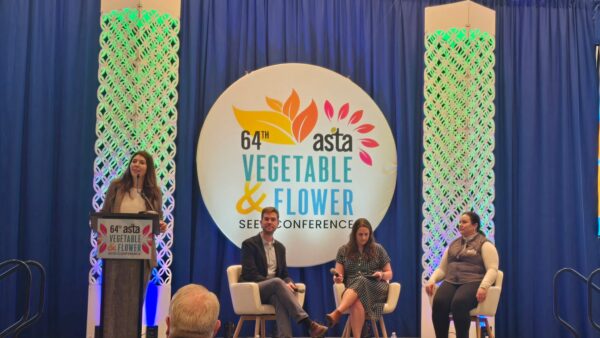The availability of a broad base of genetic resources across numerous crops around the world is critical—what more needs to be done to ensure access?
In June 2004, 40 nations ratified the International Treaty on Plant Genetic Resources for Food and Agriculture. The treaty’s chief objectives are the conservation and sustainable use of plant genetic resources for food and agriculture, and the fair and equitable sharing of benefits derived from their use. The treaty works in harmony with the Convention on Biological Diversity for sustainable agriculture and food security.
Countries which signed the treaty agreed to establish an efficient, effective and transparent multilateral system to facilitate access to plant genetic resources for food and agriculture.
What are the conditions for access in the multilateral system? Resources may be obtained for utilization and conservation in research, breeding and training. When a commercial product is developed using these resources, and if the product may not be used without restriction for further research and breeding, the treaty provides for payments of an equal share of the resulting monetary benefits. If others may use the product, payment is voluntary.
Putting a System in Place
“The Convention on Biological Diversity delegated to the Food and Agriculture Organization determining terms for access and benefit-sharing for genetic resources used in food and agriculture,” explains Stephen Smith, research fellow for Pioneer. “These genetic resources are vital to the world and quite a different character in terms of value and global distribution than might be a wild plant–for example, a tree in a rainforest containing chemicals that might help find a cure for cancer.”
Prior to the International Treaty, genetic resources were viewed as the “common heritage” of humankind. However, with the development of intellectual property rights came concerns for the conservation of those resources and sharing of equity in their use. Earlier developments in international agriculture, notably the green revolution, also resulted in the development of gene banks to conserve farmer-developed landrace varieties. Most of these collections are now held under the auspices of the United Nations within the Consultative Group on International Agricultural Research (CGIAR) system, a global partnership that engages in research for sustainable development.
For example, CIMMYT in Mexico is a large repository for the wheat and maize gene pool, the International Rice Research Institute is located in the Philippines and maintains a large gene bank, and another gene bank is ICRISAT in India. These various centers are primarily funded by governments and foundations. With the advent of the CBD, genetic resources were removed from common heritage status and placed under national sovereignty, which by its very bilateral nature leads to increasing complexity.
“In essence this bilateral approach meant that each government, or each company, had to work out the terms of agreement by which selected genetic resources could be accessed by another company or government,” says Smith, “with the understanding being that benefit-sharing terms could provide some flow back to the providers of those genetic resources in money, in education or in capacity-building. The concept was to fund the conservation of genetic resources for mutual benefit under a bilateral system.”
More Work to be Done
However, Smith points out two huge problems. “Who in each country has the rights within that given country to allow any other individual company or government to use those materials and to write agreements and contracts?” he asks. “The next problem is the cumbersome nature of bilateral agreements. Every country would have to work out an agreement with every other country, potentially for each species. That is problematic for any country, and practically impossible for most small countries.”
Smith acknowledges the critical importance of accessing a broad range of genetic diversity, but also stresses the importance that intellectual property is respected. “It is important to put royalties back into the International Treaty System if you use materials from that system. Currently you only have to put monies back into the system if you patent a derivative from that system.”
In simpler terms, if you commercialize something that has some pedigree from the system, you should be putting some money back into the system.
However, the International Treaty System is not Pioneer Hi-Bred’s first choice for accessing a broad range of genetic diversity. “We would like to see the material transfer agreement revised so that it is more in line with business realities and thus really encourages more investments into research and development with those genetic resources,” says Smith. “Nonetheless, we at Pioneer would like to see the United States ratify the International Treaty because we believe the United States should be a more visibly active high-level global participant in supporting the conservation, exchange and use of plant resource materials.”
The CBD program requires each country to designate a focal point; using this, another country can, with legal certainty, sign an agreement for use of particular materials in their research and development program. Smith’s concern is that, so far, very few countries have established those focal points, and without these there can be no prospect of forming a legally binding agreement.
“No company can afford the investment of 10 or 20 years into a research program to find out later, when a commercial product emerges, that there never was a legal certainty to use that material. These focal points and relevant legislation, coupled with processes that are not unduly burdensome, have to be in place to allow a bi-lateral CBD type system to work,” he says. “The International Treaty provides the required level of legal certainty, at least for access and benefit-sharing with regard to genetic resources for use in food and agriculture.”
As more seed firms take on international dimensions, this treaty gains even more value because it permits the transfer of germplasm from one breeding station to another, i.e., from one country to another.
Pioneer senior communications manager Sharyl Sauer says that Pioneer has made a number of instruments available to the academic community, which allow the user access to Pioneer’s commercial germplasm for their own particular research program. A “new letter of understanding” permits a university to do agronomic testing on this germplasm without notifying Pioneer.
Smith thinks it is vital that genetic resources in these various international centers continue to be accessible to the public domain. But that means governments in various countries need to “step up to the plate” and provide the majority of funding, because these centers are for the public good now and in future centuries. This also means financial and political support should come from global seed, genetic and food and processing industries.
“For the long-term public good, the availability of a broad base of genetic resources across numerous crops, including fruits and vegetables, is critical. This requires long-term funding largely from governments and foundations. If each of us were to rely only upon the food crops developed by Pioneer, Monsanto or Syngenta breeders, we would have a rather boring time at the grocery store.”
Dick Hagen
Photo Credit: Mari Tefre/Svalbard Global Seed Valult











